Author: Hildi Hawkins
New from the archives
19 February 2015 | This 'n' that
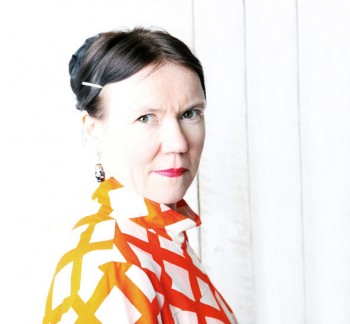
Rosa Liksom. Kuva: Pekka Mustonen
When the pseudonymous Rosa Liksom (born 1958; real name Anni Ylävaara) burst on the Finnish literary scene in 1985 with her first book, Yhden yön pysäkki (‘One night stand’), excitement was intense. For a start, she managed to keep her real identity secret, even when she appeared at public events and book-signings; then, she wrote generally in her native northern Finnish dialect, which hadn’t previously been heard very much in literary circles. Her very short short prose charted landscapes also not much represented in literature – the far north, the uneducated, the dispossessed.
This group of seven stories, from her second book, Tyhjän tien paratiisit (‘Paradises of the open road’, 1989), cover territory which has become familiar in her work: a woman who marries a layabout, a bellicose butcher’s son, a cleanliness fanatic for whom hygiene is more important than human relationships….
Rosa Liksom won the Finlandia Prize in 2011 for Hytti nro 6, which was published by Serpent’s Tail, London, in a translation by Lola Rogers last year.
*
The digitisation of Books from Finland continues apace, with a total of 360 articles and book extracts made available online so far. Each week, we bring a newly digitised text to your attention.
Not joined up
19 February 2015 | In the news

Photo: Brad Flickinger / CC BY 2.0
The news that Finnish schools are to stop teaching cursive writing, in favour of a new emphasis on touch typing and the most efficient way of composing a text message, has been widely reported in the British press.
But not in our household.
With three children – aged 13, 9 and 6 – all struggling, to a greater or lesser degree, to make sense of the curlicues of joined-up writing as it’s taught in British schools, the pressure to abandon school in London and move to Finland would be all but irresistible if they every got to hear the news.
With letter-forms that bear little resemblance to printed characters and a loopy style, apparently derived from old-fashioned copperplate, that few children are going to be able to master completely, let alone develop into an elegant mode of handwriting, joined-up handwriting remains for many an obstacle to, not a means of, communication.
Added to the benefits of Finnish schools my children already know about – the shorter working days, the lighter homework load, the absence of school uniforms, the good school meals, the outdoor breaks every hour – the news that not only will Finnish schoolchildren not be expected to develop good handwriting, but will be issued with tablets on which to practise their computer skills, would axe their enthusiasm for school at home in Britain.
For their mother, the puzzle remains how Finland manages to employ such child-friendly school policies and still remain close to the top of the global Programme for International Student Assessment (PISA) assessments. The trick seems to be to recruit top-level graduates into well-run teacher training schemes, pay them well, and to trust them to do their job as teachers, without the mounds of paperwork and need for incessant testing that bedevil the job in Britain.
About the handwriting, my children will find out soon enough, when their friends in Finland come home carrying not exercise books but tablets.
But meanwhile, I’m keeping my fingers crossed they don’t see this piece.
New from the archives
19 February 2015 | This 'n' that

Tua Forsström. Photo: Mao Lindholm
Some weeks the digitisation project turns up material we’ve all but forgotten about; other times it’s like greeting an old friend. The poet Tua Forsström’s voice belongs in the second category: quintessentially feminine, wise, simultaneously vulnerable and strong, she is a quiet, watchful observer of everyday life, fixing the chimerical, the evanescent not with, it seems, but between, the words of her poems. This extensive selection of poems is introduced by her friend and fellow poet, Claes Andersson.
Born in Porvoo in 1947, Forsström publishes rarely. She won the Nordic Council Literary Prize in 1998 with Efter att ha tillbringat en natt bland häster (‘After having spent a night with horses’, 1997). Her breakthrough into the English-speaking world came in 1987 with her sixth collection, Snow Leopard (Snöleopard), which was translated into the English by David McDuff and published by Bloodaxe Books. We’ve featured her work regularly, including her most recent collection, En kväll i oktober rodde jag ut på sjön (‘One evening in October I rode out on the lake’, Söderströms, 2012), with an introduction by Michel Ekström.
*
The digitisation of Books from Finland continues apace, with a total of 358 articles and book extracts made available online so far. Each week, we bring a newly digitised text to your attention.
Baby-boxes
18 February 2015 | This 'n' that
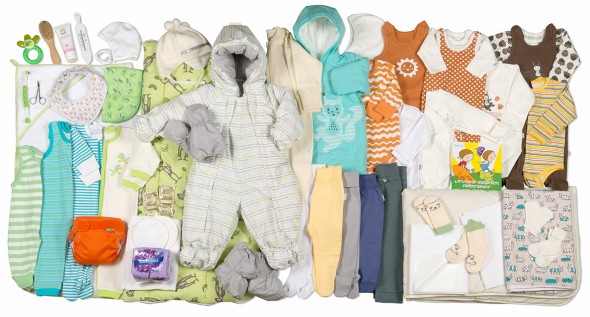
Contents of the Finnish baby-box. Photo: Annika Söderblom © Kela
Shortly before my first baby was born – ah, all of thirteen years ago, and a bit more – I paid a visit to the baby department of a central London department store.
Surrounded by push-chairs, feeding pillows, milk-expressers, nappy bins, nappy sacks, pink baby-grows, blue baby-grows, and advice books of every persuasion, I felt bewildered. The choice seemed infinite. Surely it couldn’t be this complicated.
I picked up one of the books. ‘6:30 Get up with your baby.’ I don’t think so, I objected inwardly. I’ve never been an early bird. ‘7:30 Breakfast: toast and marmalade.’ Definitely not. No one was going to tell me what to eat, or when. Were they? What on earth was this brave new world of motherhood going to be like? More…
New from the archives
13 February 2015 | This 'n' that
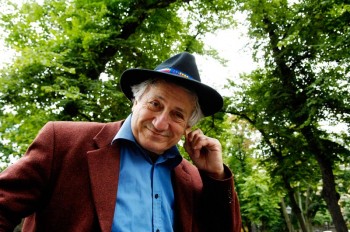
Daniel Katz. Photo: Veikko Somerpuro/WSOY.
In the midst of today’s richly cosmopolitan literary scene – we’re thinking of blockbusters like Sofi Oksanen’s Puhdistus (Purge, 2008), or Patjim Statovci’s Kissani Jugoslavia (‘My cat Yugoslavia’, 2014) (linkit) – it’s hard to imagine the colour and excitement represented by the work of Daniel Katz (born 1938) from the publication of his first book, Kun isoisä Suomeen hiihti (‘When grandfather skied to Finland’, 1969) onward. Characterised by dark humour, gentle irony, a wild imagination and a profound world view, Katz’s writing is informed but never defined by his outsider status as a Jew writing in Finnish.
Today’s story, taken from Katz’s book Talo Sleesiassa (‘A house in Silesia’) describes the journey taken by Erwin, a German Jew, to visit the home he lived in before the Second World War. Katz has a fine grasp of the ironies of history:
‘We arrived at the city of his birth, which currently is referred to as The City, for the sake of simplicity and tact: the town has – used to have, rather – two names, a German and a Polish, and one or the other party might take offence. My brother-in-law had in fact been born in a city whose name began with a B, though now it began with a W. Evolution of this kind is called phonetic history.’
The extract is accompanied by an interview of Daniel Katz by Daniel Katz.
*
The digitisation of Books from Finland continues apace, with a total of 356 articles and book extracts made available online so far. Each week, we bring a newly digitised text to your attention.
Iconic Inha
5 February 2015 | This 'n' that
From time to time we have featured the charismatic photographs taken of Helsinki by I.K. Inha (1865-1050) in 1908 – most recently in a book pairing Inha’s iconic images with contemporary photographs of the same scenes by Martti Jämsä (2009). Fifty-one of the images have now been made available online to the public for the first time on the Finnish Museum of Photography’s Flickr page.
Many of the scenes are so little changed that it’s a shock to see them peopled with behatted gentlemen and ladies in long skirts. Commissioned for Finland’s first travel guide, the photographs show the handsome buildings, parks and seafronts of a solidly bourgeois looking city that is still the capital of a Russian province, an autonomous Grand Duchy actively fostering the dream of independence that is to be realised nine years later, in 1917.

Student Union Building on Itäinen Heikinkatu (now Mannerheimintie). I.K. Inha, 1908.
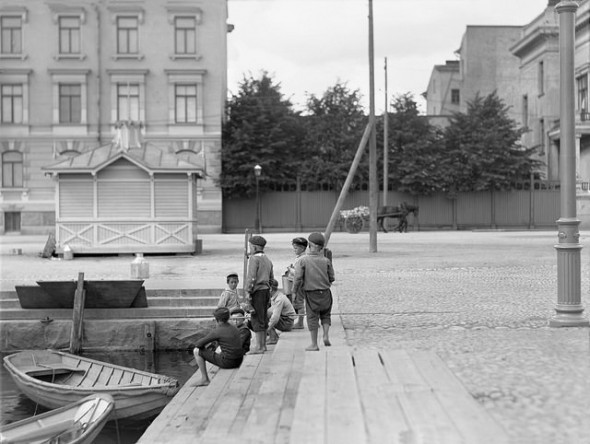
Boys at Hietalahti harbour. I.K. Inha, 1908.
Poets, pastries and prizes
5 February 2015 | In the news

Joni Skiftesvik. Photo: Hilkka Skiftesvik
The Runeberg Prize for fiction is awarded to Joni Skiftesvik (67) for his autobiographical novel Valkoinen Toyota vei vaimoni (‘The white Toyota took my wife’).
Today, 5 February, is celebrated in Finland as the birthday of the poet J.L. Runeberg (1804-1877), known as the Finnish national poet, and writer – among many other things – of the lyrics of the national anthem.
In addition to the eating (in the Books from Finland offices, at least) of the rather delicious Runeberg cakes, it is also marked by the annual award of the Runeberg Prize, worth 10,000 euros.
The book tells the often harrowing story of Skiftesvik’s family, including illness, estrangement and death. In making the award, the jury commented: ‘This story appeals to the emotions, it touches the reader; but most important of all, after the book is closed, a miracle happens: its weighty content lives on in the mind, growing day by day. Many good novels have been written, but a masterpiece is recognised from its lasting effects.’

Runeberg’s favourite. Photo: Ville Koistinen
New from the archives
5 February 2015 | This 'n' that
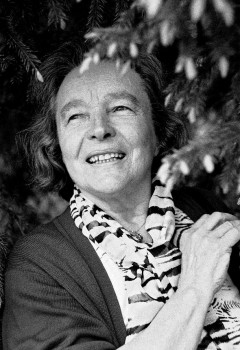
Eeva Kilpi. Kuva: Veikko Somerpuro
When we first published this piece, evacuation in Europe was a distant memory. The violent events that were to take place in what was then still Yugoslavia – Serbia, Croatia, Slovenia, Bosnia, Kosovo – were still to come.
Reading Kilpi’s description of her departure from eastern Karelia as an 11-year-old girl in 1939 with these more recent events in mind makes her evocation of the as-yet-unshattered familiarity of everyday life, the fragility of her prayers that everything will be all right, all the more poignant.
Kilpi (born 1927) is a poet, short-story writer and novelist who shot to international fame with her experimental, erotic novel Tamara (1972; English translation Tamara). She won the Runeberg Prize in 1990 for Talvisodan aika (‘The time of the winter war’), from which this extract is taken.
*
The digitisation of Books from Finland continues apace, with a total of 355 articles and book extracts made available online so far. Each week, we bring a newly digitised text to your attention.
New from the archives
29 January 2015 | This 'n' that
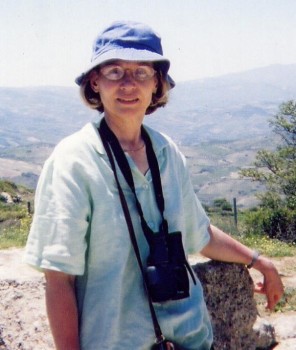
Ulla-Lena Lundberg
Low-lying, sea-girt pieces of rock strewn across the sea midway between Finland and Sweden, the Åland Islands – known in Finnish as Ahvenanmaa – are a world unto themselves. In mind and spirit they are separate from both Finland (to which they technically belong) and Sweden, giving their inhabitants, writers included, a fascinating outsider status.
This week’s archive find, an extract from Leo, the first volume of Ulla-Lena Lundberg’s trilogy set in 19th-century Åland, offers a compelling portrait of the potent mix of cosmopolitanism and (literal) isolation of the islands’ seafaring community, in which the men sail the seas and the women stay at home.
Born on Åland in 1947, Lundberg is a writer of novels, short stories, poems and other essays; her work, she says, derives from her habit of sitting under the table as a small child and listening to what the grown-ups said. She received the Finlandia Prize in 2012 for her novel Is [‘Ice’], and the Tollander Prize in 2011.
*
The digitisation of Books from Finland continues apace, with a total of 354 articles and book extracts made available online so far. Each week, we bring a newly digitised text to your attention.
Rauni Ollikainen: Finnish beginnings. A childhood in Finland. A memoir
17 October 2013 | Mini reviews, Reviews
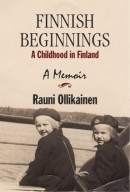 Finnish beginnings. A childhood in Finland. A memoir
Finnish beginnings. A childhood in Finland. A memoir
CreateSpace Independent Publishing Platform, 2012. 240 p., ill.
ISBN 978-1481829571
$20.40, paperback
This first volume of Rauni Ollikainen’s memoirs deals with her early life in Finland and her family’s emigration, when she was eight years old, to a new life in Vancouver, Canada. The details of her childhood, as a member of a proudly working-class Helsinki family – saunas, school, pets, her relationships with her two sisters – are lovingly chronicled. They are interestingly interleaved with the larger history around them – the Winter and Continuation Wars, and Ollikainen’s own evacuation to Sweden, which she was, frustratingly for the reader, too small to remember, and the uncertain political situation in which Finland found itself after the war, which was to prompt the Ollikainens’ departure. The book ends with the early years in Canada as the family begins to find its feet, with more promised in a follow-up volume. Although it would benefit from more in the way of narrative drive, this rich and well-observed memoir gives voice to the experience of thousands of emigrant Finns.
Katja Hagelstam & Piëtke Visser: 20+12 design stories from Helsinki
4 April 2012 | Mini reviews, Reviews
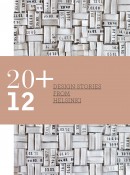 20+12 design stories from Helsinki
20+12 design stories from Helsinki
Helsinki: WSOY, 2011. 191 p., ill.
ISBN 978-951-0-38120-5
€35, hardback
In Finnish:
20+12 muotoilutarinaa Helsingistä
ISBN 978-951-0-38136-6
In celebration of Helsinki’s status as World Design Capital 2012 comes this volume of vignettes of the city’s designers. Twenty Helsinki designers and artists – from textile designers and animators to illustrators and industrial designers – are interviewed by Eva Lamppu about their work and the inspiration they find in their city. The result, handsomely illustrated with atmospheric photographs by Katja Hagelstam, is a fascinating composite portrait, a colourful patchwork of creative lives lived out against the compact and interconnected fabric of this small northerly capital, which – not unexpectedly – is revealed as both sympathetic and conducive to good design. The book is rounded off by suggestions from 12 people active in creative fields on the city’s future. A fascinating and heartwarming study.

